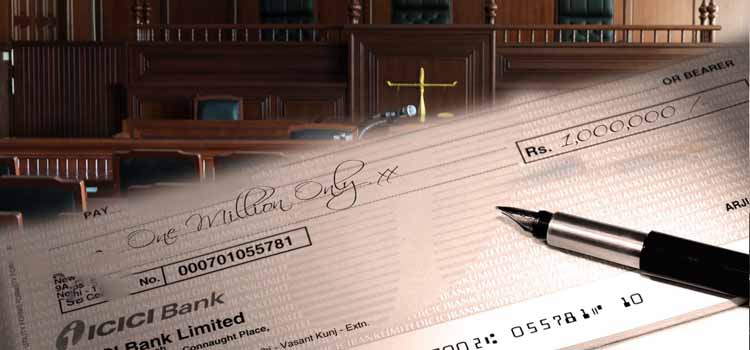Cheque Bounce Case Procedure In India
Posted On : April 6, 2022

Table of Contents
Have you ever drawn a cheque in the name of another, or received one in your own name? Then you must be aware of how cheques work as a negotiable instrument for payments. But not everyone is aware of how it is dishonoured and what are cheque bounce reasons. Know the rights after cheque bounce beforehand. Hereunder, all such things have been explained with focus upon the cheque bounce case procedure in India.
What is a Cheque Bounce Case?
When you draw a cheque in the name of another, you become the drawer and the person in whose favour such a cheque is drawn is the payee. If the payee goes to the bank for encashment of such cheque and the same is denied due to technical reasons, it is an instance of cheque bounce. ALso, the cheque bounce reasons vary from unmatched signatures to errors in account number. However, cheque bounce due to insufficiency of funds is not a casual act but is a criminal offence. Cheque bounce case procedure in India can be invoked under civil as well as criminal laws.
Contact Cheque bounce lawyers Noida now!
Cheque bounce case is the layman terminology to the technical or legal term i.e. dishonour of cheque. Cheque bounce case section 138 under Negotiable Instruments Act, 1881 punishes dishonour of cheque due to insufficiency of funds in a bank account. There is a precondition that the payment supposed to be made through such dishonoured cheque should have arised through a debt amount or legal liability. Payment for gifts or donations through cheque are not punishable through cheque bounce case section 138.
Cheque Bounce Reasons
There are several reasons for cheque bounce in India. A cheque may be returned without payment due to a lot of technical reasons. However, cheque bounce case section 138 may be invoked as per the Negotiable Instruments Act, 1881 only in case of insufficient funds. Some of the usual cheque bounce reasons have been reiterated below:
- Insufficient funds
- Account frozen
- Absence of drawer’s signature
- Irregularity in signature
- Overwriting in signature
- Invalid date on cheque
- Difference of amount in words and numbers
- Damaged cheque
- Payment stopped by cheque drawer
- Overwriting on cheque
Consult with Cheque bounce lawyers Jaipur.
Time Limit for Cheque Bounce Case
Once a cheque is dishonoured by the bank, a memo will be attached explaining the cheque bounce reasons. After this instance, cheque bounce police complaint should not be rushed, nor should the cheque bounce case procedure in India should start. First, inform the concerned drawer of the cheque regarding dishonour. He is supposed to eradicate the insufficiency of funds in his account so that the payee can get the amount the second time. However, if that is not the case, the payee is required to serve a legal notice to the drawer regarding cheque bounce within 30 days of receiving information from the bank regarding dishonour of cheque. This legal notice mentions all the details regarding the payment requirement and cheque bounce case section 138 under NPA and the time limit of 15 days. Within 30 days of expiry of this 15 day notice period, the payee can initiate cheque bounce case procedure in India. The key pointers on time limit for cheque bounce in India are:
- Production of cheque for encashment during validity period;
- Serving legal notice to payee for cheque bounce reasons within 30 days of bank intimation;
- Payee to eradicate insufficiency of funds in bank account within 15 days of notice;
- Cheque bounce police complaint within 30 days of legal notice expiry.
Also check Cheque bounce lawyers Lucknow for legal advice.
What is the Legal Procedure for Cheque Bounce?
What happens in cheque bounce case is similar to any other legal matter. The cheque bounce case section 138 starts with a dishonour of cheque occurring out of a debt or legal liability. Steps for Cheque bounce case procedure in India are as follows:
- There is a dishonour of case
- Legal notice is served within 30 days of such dishonour
- 15 days gone since the notice was served
- Cheque bounce reasons are not corrected by the cheque drawer
- Cheque bounce police complaint lodged within 30 days of expiry of given 15 day period
- Cheque bounce lawyers shall file the case under Section 138 of Negotiable Instruments Act, 1881 before the court in continuation of the said cheque bounce police complaint.
- The court shall summon the drawer of cheque as mentioned in the suit for cheque bounce case section 138
- The drawer of cheque, i.e. the accused hereby, shall give his statement before the court
- The plaintiff shall place relevant documents including the returned cheque and legal notice for cheque bounce format before the learned court
- The court will weigh the statements of both the sides as well as evidence produced before it and decide whether it was a case of cheque bounce case section 138 of Negotiable Instruments Act, 1881.
- Court judgment will lay whether and how much amount the plaintiff gets based on mental and monetary losses borne.
How Serious is a Cheque Bounce Case?
As per the Section 138 of Negotiable Instruments Act, 1881, the punishment for dishonour of cheque due to insufficiency of funds may be fine that is double the amount in cheque or imprisonment upto 2 years or both. What happens in cheque bounce case depends upon the facts of the case. However, the said cheque bounce police complaint falls under bailable and compoundable offences which makes it less serious financial offence. There are talks around decriminalisation of cheque bounce matters as well under Section 138.
How to Escape from a Cheque Bounce Case?
If it is a genuine case of Section 138 under Negotiable Instruments Act, 1881, there is no escape for the accused and there is no scope for downfall for the prosecutor (payee) as well since evidence is available in hard copy. However, false cheque bounce cases may be a trouble for an innocent person. In that case, cheque bounce lawyers may be of great help. Thus, escape from a cheque bounce case can be confirmed through the following check points:
- Take care of account balance before drawing cheque in favour of another
- If it happens due to any cheque bounce reasons, fix or correct the same
- In case of insufficiency of funds, adjust the same in your account
- Do not pay in cash in lieu of the payment initiated through cheque
- If a genuine cheque bounce case section 138 starts, initiate compromise and anyhow pay the required sum
- Do not let a loan payment cheque bounce, otherwise it will be a case taken up by banking lawyers under Negotiable Instruments Act. In addition, late fees will also apply for non-payment of loan instalments.
























